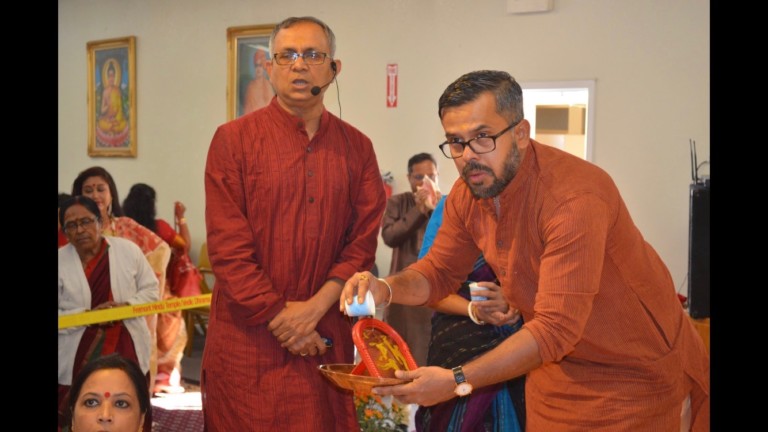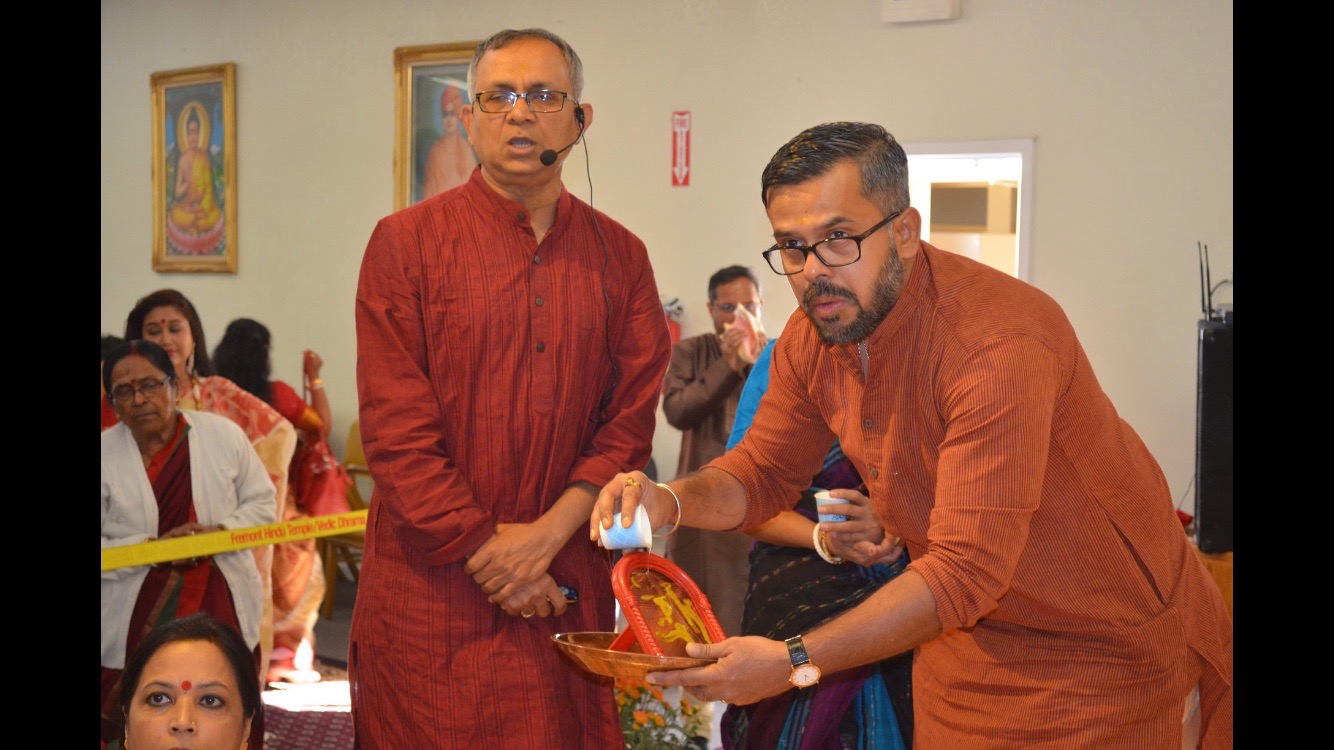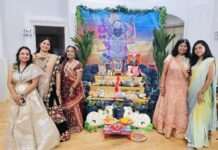
FOG Bengal Priests – Mainstream Scientist and Engineer, Custodians of Hindu culture and Philosophy
Jayanta Panda is the main priest of FOG Durga Puja. He has a Ph.D. in Aerospace Engineering and works at NASA. He is extremely passionate about Vedic history and philosophy. Sudev Mukherjee, a senior engineering manager at Amazon, has been helping him with the rituals.
India Post had a conversation with the duo on the origins of their foray into this religious path.
Dr. Panda came to this country when he was just 22 years old. Although he hails from the Panda clan (priests in Bengal) – his grandfather was a Goddess Kali worshipper – he was not very religious. In fact, he came by this path through strange coincidences – meetings with some Chinese and Korean colleagues who knew about meditation and Buddhism, both part of India’s ancient heritage.
His Korean friend who had come to the US as a student, had learnt meditation after his father had done so and exhorted him to follow suit. Jayanta’s Chinese colleague was surprised and excited at the mention of his friend’s name, ‘Amitabha,’ a name that he has recited in front of the statue of Lord Buddha. Amitabha is the principal Buddha in Pure Land Buddhism, a branch of East Asian Buddhism (reference – Wikipedia.org).
“I kept seeing it’s me who is empty”, said Jayanta. “And then I started seeing my own kids grow up. They grew up in the Midwest, where we were the only colored people.”
He noticed that everybody else would go to church and they would not. “And pretty soon, it was very clear to us they are feeling an emptiness although it is there within ourselves.”
Jayanta Panda had his initiation from Dr Pakrashi of Cleveland, Ohio, who is a cardiologist by profession, and a priest after work. He went on to become a member of various clubs.
However, when his children crossed 13-14 years old, he had a realization. “I realized that in spite of my best efforts, we’ll always have very poor skill in Bengali, even in Hindi or Tamil or Telugu languages…and also, they basically stopped listening to Indian music and things.”
A question came up in his mind, “How am I going to perpetuate my culture?”
It occurred to him that his kids always showed very great respect for anything to do with philosophy and Hinduism, so that was his thought motivation.
“Our songs, our dances, our music, and our culture are all intimately tied to our ‘Protimas’ and our philosophies and our ‘pujas’. ”
On making the Fremont Hindu Temple the center for the FOG Durga Puja, Dr. Panda said, “I realized that within American society, the church plays a big role. It’s unlike India. Basically, every social service is given to the church. And you can get all your money and spend it on buying food and bringing artists, but at the end…we have to build an establishment. And that’s what brought Sudev and myself close to the temple. And we hope this is the place for us to perpetuate.”
Further, he pointed out that immigration in the US is at an all time high right now. It has always gone through ups and downs. “And there’ll be a down time when there will not be direct immigration from India. People like us have taken citizenship and consider that this is our country. And although India is, of course, very close to us – we are still as Indian as possible – but, in this country, we need to establish ourselves.”
Sudev Mukherjee was more of a left liberal (the state of West Bengal had repeatedly elected the Communist Party of India (CPI) for decades). His family was very religious, but he saw the rituals more as fun. He said, “I got my thread ceremony and never really wear the thread.”
However, things began changing. “Over time, after I came here, I understood the importance of religion”, he revealed. As he watched Jayanta Panda performing the ‘puja’, things started to make sense.
It was during a communal Durga Puja that he had a strange experience that brought him closer to the Divine. He kept it to himself as it was deeply personal.
He started exhorting Jayanta to do the ‘puja’ and a few years later, the duo are the priests of the annual FOG Bengal Durga Puja.
Dr. Panda explained what “Pranaprathistha” is and the reason behind his translations of the Sanskrit mantras to English. “Pranaprathistha” is the installation of the Deity in the ‘Puja’ altar and bringing Her presence to the idol or “Protima”.
He elaborated, “There are two Sanskrit words for ‘Pranaprathistha’ – ‘Mrinmayee’ to ‘Chinmayee’. Mrinmayee is one which is made of clay or maybe any ‘paththar’ (stone). Chinmayee is one who is an emblem of your thoughts. So ‘Pranaprathistha’ is a conversion process, how you basically convert Mrinmayee Devi to Chinmayee Devi.
“The Puja process itself is really an invocation of inviting the Deity through your soul and then there is this set of favorite ‘mantras’, we call them ‘Vedashuktas’…so basically, it is a combination of those mantras and your devotion and you are installing it from your soul. And there are certain parts of mantras which touch the Deity and touch your heart and you say what is in my soul becomes to You (the Divine) and I become You. So, unless someone translates these things, you will never know it.
“These are so beautiful words and that is why I try projecting the mantras and their meanings in English.”
He emphasized that it was necessary to do this for the next generation. “It is an idolatry to them, to the outside world. I have to explain to them – no, it is not!”
There are additional reasons for his pursuit. “Hinduism is a depository of knowledges which were devastated from the world. So Devi Durga, various forms of it, She is very close to Diana. ” (Diana is the Roman Goddess of the hunt.)
Jayanta Panda shared his experience visiting the famous Notre Dame cathedral in France. He saw a hole next to it that is fairly recent. Archeologists have dug the area and discovered that the cathedral was built on top of a temple of Mars.
He said, “You go to Mexico, you go to South America, you go any other places in the Middle East, all these big giant churches and other things, mosques…they were built on the destroyed things!”
He cited parallels between ancient Indian deities and those of Europe. For example, the Norse Germanic God Odin is very similar to the Indian deity, Indra. Today, all the temples to Jupiter, Venus and other ancient gods have been demolished.
However, Jayanta predicts, “History is going to be written again and it has a path through ours”.
Vidya Sethuraman of India Post asked Jayanta about their bottle gourd vegetable sacrifice in lieu of the animal sacrifice that is associated with Kali Puja.
Sudev Mukherjee chipped in. He explained that the form of Durga Puja that they perform is called ‘Akaal Bodhan’ and was originally performed by Lord Rama when he was fighting Ravana. “Navaratri is the period when Rama and Ravana fought”, explained Sudev. “On the sixth day, Bhagawan Rama was losing the battle.”
Rama prayed to Ma Durga (Kali), offering 108 lotuses (‘kamal’). When he was short of one lotus, he was about to offer his own eye, as Rama was known as “Kamalalochana” or the lotus eyed one. However, the Goddess stopped him from doing so. On the eighth day or ‘Ashtami’, a ‘puja’ called ‘Sandhi Puja’ is performed, in which 108 lamps are offered. This is the symbolism associated with the lamps.
The time of the offering is the time of ‘Sandhi Puja’ on ‘Ashtami’ when the Goddess Durga slayed the demon, Mahishasura.
Sudev said, “On ‘Nabami’ (the ninth day), we are supposed to do a sacrifice of a goat that I always wanted to do…and we eat the meat of the goat.”
The scholarly Jayanta explained that there was something called “Yagyapavita” – ‘Yagya’ is the sacrificial ceremony and Upavita is something the priests wear during the ceremony. There are theories that this was actually a sash that the priests wore to capture blood splattering as there would always be some sacrifice.
He said, “Ahimsa is a great thing ideologically, but it arose later.”
He elaborated that Hinduism was divided into 5 sects – Soorya, Ganapatya, Vaishnavite, Shaivite and Shakhya (Shakti).
He explained, “Vaishnavites are very, very strict vegetarians everywhere…but Shakti worshippers, when it was developed for many hundreds of years, they wanted to bring back the Vedic culture.” He referred to the tantras, which are related to the Vedic mantras.
Jayanta also talked about Shakti (Goddess) being described as ‘Advaita’. In ‘Advaita’, the body and soul are not separate. Rather, our body itself is a breathing ground of the Devi’s Grace.
When asked about his study of Sanskrit, Jayanta replied, “Some of the Vedic mantras are contemporaries of the pyramids.” He likened the ancient Vedic mantras in Sanskrit to the cryptic hieroglyphs, and added, “In this world, we are fortunate to maintain the similar things that were contemporary things, to be sang right now in modern times.” Both expressed thanks to Judhajit SenMazumdar of FOG Bengal who brought them on board. We are fortunate to have them.







